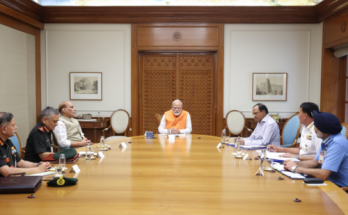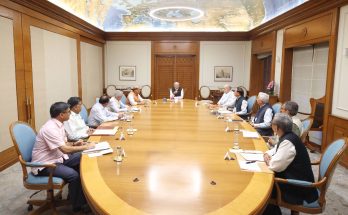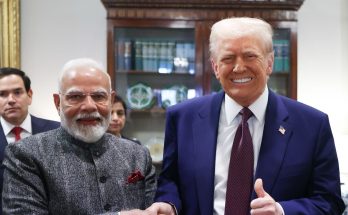By J.D. Vance
 The 21st century is going to be determined by the strength of the US-India partnership, says US Vice-President J.D. Vance in a soaring speech in Jaipur on April 22, 2025.
The 21st century is going to be determined by the strength of the US-India partnership, says US Vice-President J.D. Vance in a soaring speech in Jaipur on April 22, 2025.
In the United States, we’re proud of the deep connection between our nations, between India and the United States. Prime Minister Narendra Modi, as most of you probably know, was one of the first visitors welcomed into the Oval Office during President Donald Trump’s second term. And like President Trump, the Prime Minister inspires remarkable loyalty because of the strength of his belief in his people and in his country.
New Homes, News Skylines
There’s a vitality to India, a sense of infinite possibility, of new homes to be built, new skylines to be raised, and lives to be enriched. And there’s a pride in being Indian, a feeling of excitement about the days that lie ahead. It’s a striking contrast with too many in the West, where some in our leadership class seem stricken by self-doubt and even fear of the future. To them, humanity is always one bad decision away from catastrophe. The world will soon end, they tell us, because we’re burning too much fuel or making too many things or having too many children. And so rather than invest in the future, they too often retreat from it.
Some of them pass laws that force their nations to use less power. They cancel nuclear and other energy generation facilities, even as their choices, the choices of these leaders, lead to more dependence on foreign adversaries. Meanwhile, their message to their friends, to countries like India, is to tell them that they’re not allowed to grow.
Growing Together
President Trump rejects these failed ideas. He wants America to grow, he wants India to grow, and he wants to build the future with our partners all over the globe.
The most profound responsibility I believe that all of us have is not to ourselves, but to the next generation, to make sure we leave them with a better society than the one that our parents and our grandparents gave us. This is the world that America seeks to create with you. We want to build a bright new world, one that’s constantly innovating, one that’s helping people to form families, making it easier to build, invest, and trade together in pursuit of common goals.
The US and India have much to offer one another. And that’s why we come to you as partners looking to strengthen our relationship. Now we’re not here to preach that you do things any one particular way. Too often in the past, Washington approached Prime Minister Modi with an attitude of preachiness, or even one of condescension. Prior administrations saw India as a source of low-cost labour on the one hand, even as they criticised the Prime Minister’s government, arguably the most popular in the democratic world.
This attitude captured too much of our economic relationship with the rest of the world. So, we shipped countless jobs overseas, and with them our capacity to make things, from furniture, appliances, and even weapons of war. We traded hard power for soft power because with economic integration, we were told, would also come peace through sameness. Over time, we’d all assume the same sort of bland, secular, universal values. No matter where you lived, the world was flat after all. That was the thesis, and that was what they told us. And when that thesis proved false, or at least incomplete, leaders in the West took it upon themselves to flatten it by any means necessary. But many people across the world, and I think your country counts among them, they did not want to be flattened.
Many were proud of where they came from, their way of life, the kind of jobs they worked, and the kind of jobs their parents worked before them. And that very much includes people in my own country, the United States of America.
Manufacturing & Prosperity
We want to found our vision of the future upon the proud recognition of our heritage, rather than self-loathing and fear. I work for a president who has long understood all of this. Whether through fighting those who seek to erase American history, or in support of fairer trade deals abroad, he has been consistent on these issues for decades.
As a result, under the Trump administration, America now has a government that has learned from the mistakes of the past. It’s why President Trump cares so deeply about protecting the manufacturing economy that is the lifeblood of American prosperity, and making sure America’s workers have opportunities for good jobs. As we saw earlier this month, he will go to extraordinary lengths to protect and expand those opportunities for all Americans.
So today, I come here with a simple message. Our administration seeks trade partners on the basis of fairness and of shared national interests. We want to build relationships with our foreign partners who respect their workers, who don’t suppress their wages to boost exports, but respect the value of their labour. We want partners that are committed to working with America to build things, not just allowing themselves to become a conduit for transshipping others’ goods. And finally, we want to partner with people and countries who recognise the historic nature of the moment we’re in, of the need to come together and build something truly new, a system of global trade that is balanced, one that is open, and one that is stable and fair. Now, I want to be clear, America’s partners need not look exactly like America, nor must our governments do everything exactly the same way. But we should have some common goals. And I believe here in India, we do, in both economics and in national security. That’s why we’re so excited. That’s why I’m so excited to be here today. In India, America has a friend, and we seek to strengthen the warm bonds our great nations already share.
Critics have attacked President Trump for starting a trade war in an effort to bring back the jobs of the past. But nothing could be further from the truth. He seeks to rebalance global trade so that America, with friends like India, can build a future worth having for all of our people together. And when President Trump and Prime Minister Modi announced in February that our countries aim to more than double our bilateral trade to $500 billion by the end of the decade, I know that both of them meant it.
I’m encouraged by everything our nations are doing to get us there. As many of you are aware, both of our governments are hard at work on a trade agreement built on shared priorities, like creating new jobs, building durable supply chains, and achieving prosperity for our workers. In our meeting yesterday, Prime Minister Modi and I made very good progress on all of those points.
We are especially excited to formally announce that America and India have officially finalised the terms of reference for the trade negotiation. I believe this is a vital step toward realising President Trump’s and Prime Minister Modi’s vision because it sets a roadmap toward a final deal between our nations. I believe there is much that America and India can accomplish together.
Areas of Collaboration
I want to talk about a few areas of collaboration today, how India and the US can work together.
First, perhaps most importantly, to protect our nations. Second, to build great things. And finally, to innovate the cutting-edge technologies both our countries will need in the years to come.
On defence, our countries already enjoy a close relationship, one of the closest relationships in the world. America does more military exercises with India than we do with any other nation. The US-India Compact that President Trump and Prime Minister Modi announced in February will lay the foundation for even closer collaboration. From javelins to striker combat vehicles, our nations will co-produce many of the munitions and equipment that we’ll need to deter foreign aggressors, not because we seek war but because we seek peace and we believe the best path to peace is through mutual strength. The launching of the Joint Autonomous Systems Industry Alliance will enable America and India to develop the most state-of-the-art maritime systems needed for victory. It’s fitting that India is hosting the Quad Leaders Summit this fall. Our interests in a free, open, peaceful, and prosperous Indo-Pacific are in full alignment.
Both of us know that the region must remain safe from any hostile powers that seek to dominate it. Growing relations between our countries over the last decade are part of what led America to designate India a major defence partner, the first of that class. This designation means that India now shares with the UAE, a defence and technology infrastructure and partnership with the US on par with America’s closest allies and friends. But we actually feel that India has much more to gain from its continued defence partnership with the US, and let me sketch that out a little bit.
We want to collaborate more. We want to work together more. And we want your nation to buy more of our military equipment, which we believe is the best in class. American fifth-generation F-35s, for example, would give the Indian Air Force the ability to defend your airspace and protect your people like never before, and I’ve met a lot of great people from the Indian Air Force just in the last couple of days.
India, like America, wants to build, and that will mean that we have to produce more energy. It’s more energy production and more energy consumption, and it’s one of the many reasons why I think our nations have so much to gain by strengthening our energy ties. As President Trump is fond of saying, America has once again begun to “drill, baby, drill”, and we think that will inure to the benefit of Americans, but it will also benefit India. Past administrations in the US, I think motivated by a fear of the future, have tied our hands and restricted American investments in oil and natural gas production. This administration recognises that cheap, dependable energy is an essential part of making things and is an essential part of economic independence for both of our nations. Of course, America is blessed with vast natural resources and an unusual capacity to generate energy — so much that we want to be able to sell it to our friends like India. We believe your nation will benefit from American energy exports and expanding those exports.
You’ll be able to build more, make more, and grow more, but at much lower energy costs. We also want to help India explore its own considerable natural resources, including its offshore natural gas reserves and critical mineral supplies. We have the capacity and we have the desire to help. Moreover, we think energy co-production will help beat unfair competitors in other foreign markets. But India, we believe, can go a long way to enhance energy ties between our nations, and one suggestion I have is maybe consider dropping some of the non-tariff barriers for American access to the Indian market.
We believe that American energy can help realise India’s nuclear power production goals — and this is very important — as well as its AI ambitions. Because as the US knows well, and I know that India knows well, there is no AI future without energy security and energy dominance. And that brings me to my final point of collaboration.
I believe that the technological collaboration between our countries is going to extend well beyond defence and energy. The US-India Trust Initiative that President Trump and Prime Minister Modi have launched will be a cornerstone of the partnership in the future. It’ll build on billions of dollars of planned investments that American companies have already announced across India.
In the years to come, we’re going to see data centres, pharmaceuticals, undersea cables, and countless other critical goods being developed and being built because of the American and Indian economic partnership. I’ll say it again. I think that our nations have so much to gain by investing in one another, America investing in India, and of course, India investing in the US. I know that Americans, our people, are excited about that prospect, and that President Trump and I are looking forward to stronger ties. Americans want further access to Indian markets. This is a great place to do business, and we want to give our people more access to this country. And Indians, we believe, will thrive from greater commerce in the US. This is very much a win-win partnership. It certainly will be far into the future.
Neither Americans nor Indians are alone in looking to scale up their manufacturing capacity. The competition extends well beyond cheap consumer goods and into munitions, energy, infrastructure, and all sorts of other cutting-edge technologies. I believe that if our nations fail to keep pace, the consequences for the Indo-Pacific, but really the consequences for the entire world, will be quite dire.
This, again, is where India and the US have so much to offer one another. We’ve got great hardware, the leading artificial intelligence hardware in the world. You have one of the most exciting startup technology infrastructures anywhere in the world. There’s a lot to be gained by working together. And this is why President Trump and I both welcome India’s leadership in a number of diplomatic organisations, but, of course, in the Quad. We believe a stronger India means greater economic prosperity, but also greater stability across the Indo-Pacific, which is, of course, a shared goal for all of us in this room, and it’s a shared goal for both of our countries.
We are now officially one quarter into the 21st century, 25 years and 75 years to go. I really believe that the future of the 21st century is going to be determined by the strength of the US-India partnership. I believe that if India and the US work together successfully, we are going to see a 21st century that is prosperous and peaceful. But I also believe that if we fail to work together successfully, the 21st century could be a very dark time for all of humanity.
President Trump intends to rebalance America’s economic relationship with the rest of the world. That’s going to cause, fundamentally, profound changes within our borders and the US, but of course with other countries as well. But I believe that this rebalancing is going to produce great benefits for American workers. It’s going to produce great benefits for the people of India. And because our partnership is so important to the future of the world, I believe President Trump’s efforts — joined by India and Prime Minister Modi — will make the 21st century the best century in human history.
Let’s do it together.
(This article is an edited excerpt of the speech by US Vice President J. D. Vance in Jaipur, delivered on April 22, 2025)
Author Profile
- India Writes Network (www.indiawrites.org) is an emerging think tank and a media-publishing company focused on international affairs & the India Story. Centre for Global India Insights is the research arm of India Writes Network. To subscribe to India and the World, write to editor@indiawrites.org. A venture of TGII Media Private Limited, a leading media, publishing and consultancy company, IWN has carved a niche for balanced and exhaustive reporting and analysis of international affairs. Eminent personalities, politicians, diplomats, authors, strategy gurus and news-makers have contributed to India Writes Network, as also “India and the World,” a magazine focused on global affairs.
Latest entries
 India and the WorldApril 30, 2025Pahalgam terror attack: Modi provides armed forces full freedom to act
India and the WorldApril 30, 2025Pahalgam terror attack: Modi provides armed forces full freedom to act India and the WorldApril 23, 2025Kashmir terror: India hits back at Pakistan, highlights cross-border linkages
India and the WorldApril 23, 2025Kashmir terror: India hits back at Pakistan, highlights cross-border linkages India and the WorldApril 23, 2025The Century of America and India: Growing Together
India and the WorldApril 23, 2025The Century of America and India: Growing Together In ConversationApril 20, 2025India Can Contribute Largely to Development of Morocco’s Defence Industry: Ambassador
In ConversationApril 20, 2025India Can Contribute Largely to Development of Morocco’s Defence Industry: Ambassador

 The 21st century is going to be determined by the strength of the US-India partnership, says US Vice-President J.D. Vance in a soaring speech in Jaipur on April 22, 2025.
The 21st century is going to be determined by the strength of the US-India partnership, says US Vice-President J.D. Vance in a soaring speech in Jaipur on April 22, 2025.





